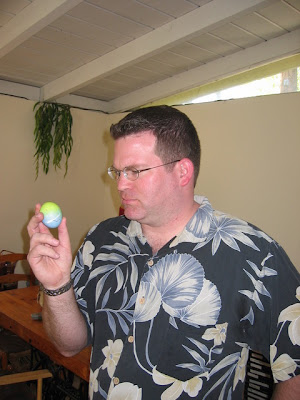A while ago Jon Lange had wondered about the population distribution among the
different time zones of the United States. Obviously the Eastern Time Zone has the biggest U.S. population, and the Mountain Time Zone has the lowest population of the four time zones in the contiguous United States.
But what about the
other U.S. Time Zones? The
Code of Federal Regulations, Title 49, Part 71 defines nine different time zones for U.S. states and territories, including the four familiar time zones plus the
Atlantic Time Zone,
Alaska Time Zone,
Hawaii-Aleutians Time Zone,
Samoa Time Zone, and
Chamorro Time Zone (in Guam). Oddly enough, they don't define the time in the
minor outlying islands; probably those use
nautical time.
Let's take a closer look at the Hawaii-Aleutians Time Zone, which is
two hours earlier than the
Pacific Time Zone. The State of Hawaii doesn't use
Daylight Saving Time, so right now people in Hawaii are three hours earlier than I am
here in California. But what about the West
Aleutians? They're in the same time zone as Hawaii, but they do use DST, so they're two hours behind me here, the only part of the country that currently uses the
UTC-9 time offset.
Now let's think back to the original question about population distribution. How many people in the United States are currently two hours behind Pacific Time? This took a lot of poking around on the Census's
American Fact Finder. Conveniently, all of the territory in question is in the
Aleutians West Census Area (AWCA), but I had to separate out the parts of the AWCA that use Alaska Daylight Time (AKDT) from the parts that use Hawaii-Aleutians Daylight Time (HADT). The
time zone boundary is at the 169°30' W longitude line,
in Samalga Pass between the
Fox Islands and the
Islands of Four Mountains, but only in the Aleutian Islands themselves.
There are seven
Census-designated places or cities in the
AWCA. One of them, the city of
Unalaska, forms its own Census tract (
Tract 2, population 4,283), but everything else is in
Census tract 1, which totaled 1,182 persons in 2000. The Tract 1 towns have
the following populations:
Subtracting 1,151 from 1,182, that means there are 31 people in Tract 1 of the Aleutians West Census Area that don't live in
a town or Census-designated place. But on which side of the time zone boundary do they live? For that, I dug through
the block-by-block data and
reference maps, and discovered where the Mystery People live:
All three of these locations are west of the 169°30' W longitude line, so they're in the Hawaii-Aleutians Time Zone. Adding the 31 Mystery People to the populations of Adak, Atka, and Attu Station brings the total U.S. population within that time zone observing DST to only 459 persons. Since most islands in the Pacific don't observe DST, the only other populated place in the world observing
UTC-9 time right now is the
Gambier archipelago of French Polynesia, which has a population of only 986!
Note 1: It would tickle me pink if there were a social club or something like that in Unalaska called the
House Committee on Unalaskan Activities.
Note 2: I'll calculate the populations of the other time zones later.
Note 3: We're late enough in the decade now that the results of the 2000 Census are getting out of date. Just 2 more years to go!
Note 4: I had to go in and correct the Wikipedia page on
Nikolski, which somebody had
mistakenly put in the Hawaii-Aleutians Time Zone.
Note 5: I'm
not that experienced in Wikipedia editing, so I don't think I made the references in the most efficient way possible. Specifically, I'd like the reference list to just put the link on the reference, instead of after it as another reference. I'm not sure how to do that, though. If one of you has more experience and could show me, I'd appreciate it.
 The revealing part of this story is that despite the economic liberalization of the past decade-plus, the Communist government's controls on the media are strong enough that the workers didn't know what the flags represented.
The revealing part of this story is that despite the economic liberalization of the past decade-plus, the Communist government's controls on the media are strong enough that the workers didn't know what the flags represented.



